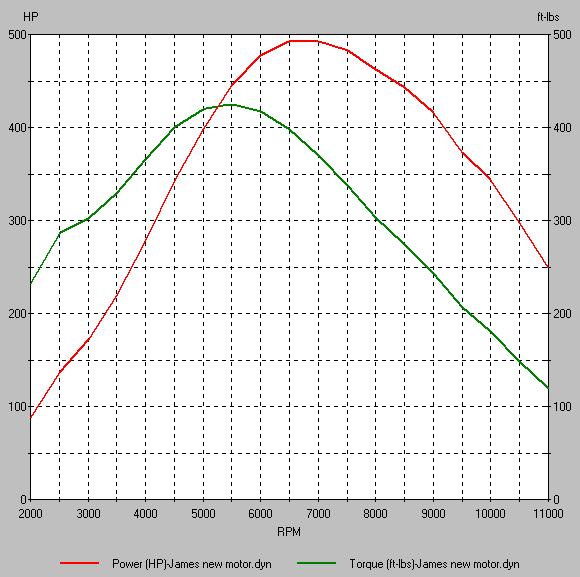
Engine
|
The power of the engine and the way the car handles really is what sets race cars apart. Unlike steam engines, modern engines don't develop much torque at low rpms. That is why cars have clutches or torque converters to let the drive line slip till the engine is at a rpm where it can run with a load (the car). Below are two simulated dyno runs generated with a program called desktop dyno. It can generate a dyno run based on the parts of your car. |

|
This is a simulated dyno run from 2.2L Honda motor. Its has fuel injection and four valves per cylinder. The camshaft that opens and closes the valves is pretty conservative. Notice the board flat torque curve. This engine has a red line at about 7000rpms, and idles well at about 700rpms. You can engage the motor at about 1300-1500rpms. If you were going to race this motor you would want to keep it at about 4000-6000 rpms, an automatic transmission would work well with this motor. |
|
This motor is my drag racing motor. I tested this motor in car with a accelerometer, and can attest to desktop dynos accuracy in predicting dyno runs. |

|
This motor is a 5.7L Chevy block. It has a lot of exotic racing parts on it. It idles at about 2000rpm, and it has so little vacuum that it requires about a 3500rpm torque converter, a special carb, and no power brakes. The max rpm is 9200rpms. As you can see the torque cover is very sharp compared to the Honda motor, this is indicative of a race motor. If you were racing this motor you would want to keep the motor at about 6000 to 7000 rpms, a small window, and that is why most race cars run a sequential transmission. When you watch race cars run, listen for the shifts, you can hear at least three or four shifts per turn. |
|
Physics plays a large part of engine design. One of the most valuable tools we have now days is highly reliable accelerometer. (Auto Math) I use desktop dyno to test new part combination before I buy them, and I use an accelerometer to measure the acceleration of the the car. With this information I can know the force my motor and drive line is generating from newton's F=MA equation. Another application of physics in racing is that many Indy race cars are starting to run v-6's with big turbos instead of v-12's since if the two motors are making the same power, and the v-12 engine has more rotating mass, we know form the equation u = .5mv^2 + .5Iw^2 that the v-12 has a larger I value, so the v-6 car is going to accelerate faster then the v-12 car of equal power since more there is more kinetic energy at any given time. (Auto Math) |